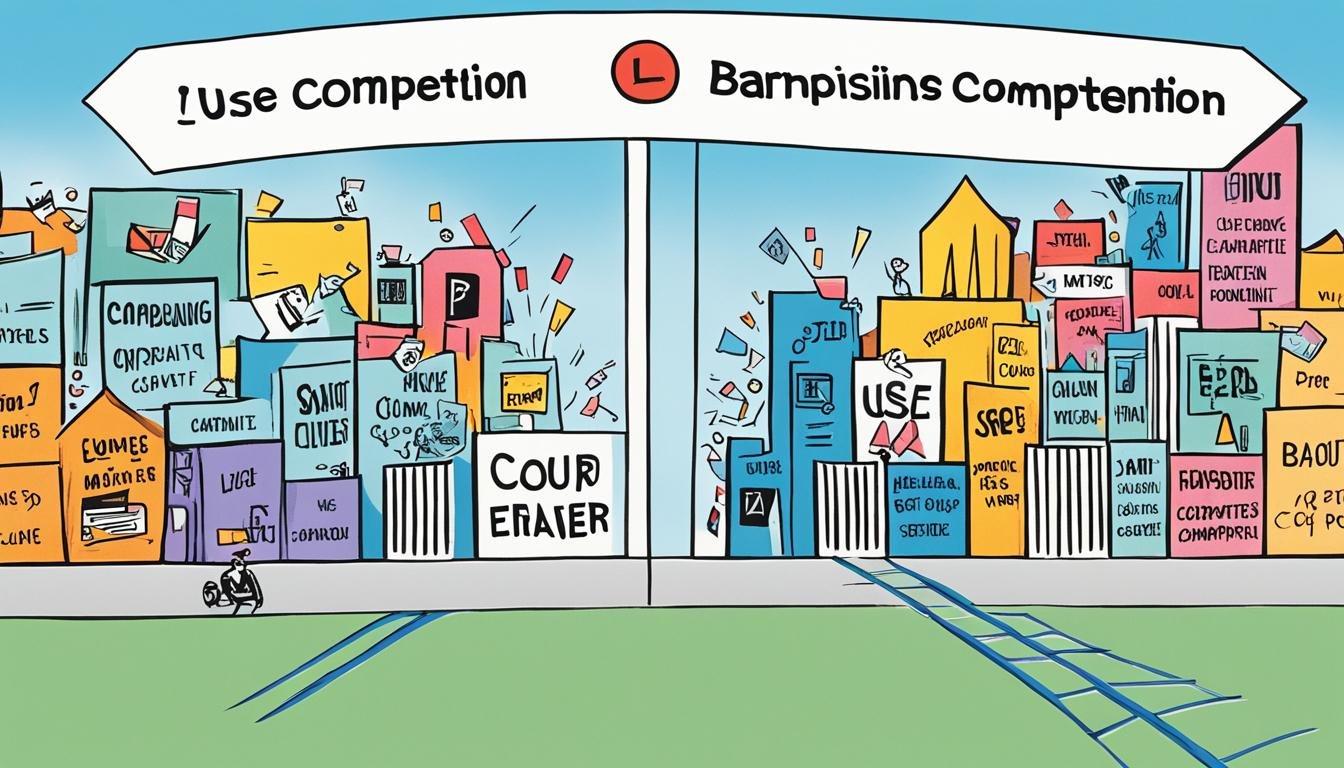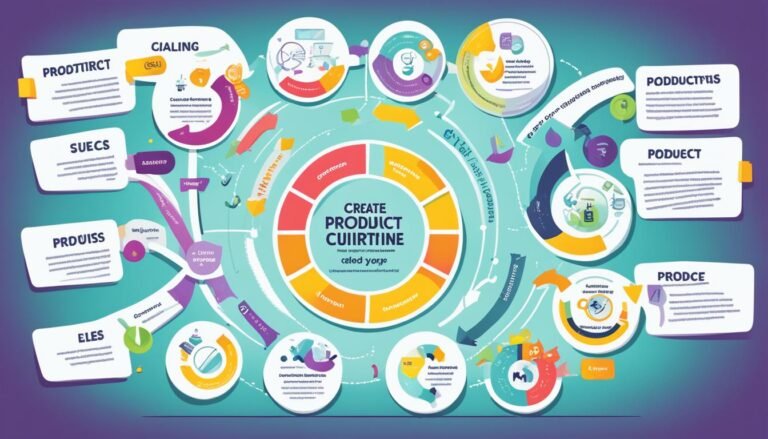Porter’s Five Forces: Industry Analysis for Competitive Advantage
Did you know that Porter’s Five Forces framework, introduced by Michael E. Porter in 1979, is still key for understanding competitive forces in industries? This model helps businesses make a strong competitive strategy. It looks at five main areas: competitive rivalry, threat of new entrants, supplier power, buyer power, and threat of substitutes. These forces shape an industry’s profits and structure.
Today, businesses must watch for changes in the market. High industry attractiveness often means higher profits. Porter’s model breaks down each competitive force to give clear strategy. By looking at competitor sales and customer behavior, companies can find their strengths and weaknesses.
Understanding supplier and buyer power affects pricing and product quality. This framework gives firms the strategic insights they need to stay ahead in a changing market.
Key Takeaways
- Porter’s Five Forces framework, developed in 1979, is crucial for analyzing industry competitiveness.
- It explores five primary forces: competitive rivalry, threat of new entrants, supplier power, buyer power, and threat of substitutes.
- This framework helps businesses determine industry attractiveness and profitability.
- Insights from the analysis can guide long-term competitive strategy and strategic planning.
- High barriers to entry reduce the risk of new competitors, while low barriers increase it.
- Understanding customer and supplier power helps in adjusting pricing, product development, and service quality strategies.
- The analysis provides a clearer picture of market dynamics and potential threats or opportunities.
Introduction to Porter’s Five Forces
Porter’s Five Forces framework is key for a deep industry analysis for competitive advantage. It looks at five main forces that shape an industry. These forces include competition, new entrants, supplier power, customer power, and substitute threats. Knowing these forces helps businesses do a full strategic business assessment.
First, internal competition shows how fierce rivals are. Many competitors and slow growth mean tough competition. But, a growing market can make competition less intense. Products that are similar make things harder for companies because customers can easily switch.
How easy it is for new companies to join the market matters a lot. Barriers like economies of scale, being different, needing a lot of money, and access to channels can stop new entrants. But, low barriers mean companies must watch out for new competition.
Supplier power is also key in the market forces analysis. It depends on how many suppliers there are, how unique they are, and how hard it is for customers to switch. Strong suppliers can push up prices, hurting business profits.
Customer power also shapes the market. If customers can easily switch, companies must improve their products or lower prices to keep them. This makes pricing and product quality very important.
Lastly, the threat of substitutes is about how easy customers can find other products. If substitutes are easy to find, companies must keep prices low and innovate to stay competitive.
By looking at these five forces, companies can understand their industry better. This helps them find a lasting competitive edge. This method is vital for a strong market forces analysis and is key to long-term success.
Understanding Industry Rivalry
Industry rivalry means how much companies compete with each other in a market. This competition can greatly affect a company’s market share and profits. Many things influence how intense this competition is, like the number of companies, how fast the industry is growing, and how similar their products are.
Factors Contributing to Competitive Rivalry
Several key factors make competition in an industry more intense:
- Number of Competitors: More companies mean more competition, leading to lower prices and more marketing.
- Industry Growth Dynamics: Fast-growing industries often have less rivalry as companies take advantage of new chances. But, slow or shrinking industries can be very competitive.
- Product or Service Similarities: If products are very similar, companies might fight over prices and marketing to get more customers.
- Exit Barriers: High costs to leave the industry keep companies in, making competition stronger.
- Fixed Costs: High costs that don’t change can push companies to work hard, leading to lower prices to make more money and get more customers.
Examples of High and Low Rivalry Industries
Looking at certain industries shows how competition affects the market:
- High Rivalry: The soft drink industry is very competitive, with companies like Pepsi and Coca-Cola always fighting for customers. The tech industry, with Apple and Samsung, is also a place of constant innovation and customer loyalty battles.
- Low Rivalry: Some niche markets have less competition because of their unique products or few competitors. For example, industries making special machinery might have a peaceful market because there are fewer companies competing directly.
Knowing these things is key for any business making a competitive strategy. By understanding what affects competition, companies can better compete and use growth opportunities to their benefit.
The Threat of New Entrants
The threat of new entrants looks at how easy it is for new companies to join an industry. This affects the market share and profits of existing companies. Factors like entry barriers, economies of scale, and industry rules shape the competition in different sectors. Knowing these helps with planning and understanding the competition.
Entry Barriers and Their Impact
Entry barriers are key in seeing how new entrants threaten the market. High costs, brand loyalty, and hard access to channels can stop new companies. If a brand has strong loyalty, it makes it harder for new ones to enter. On the other hand, low costs, easy supplier access, weak rules, and no retaliation make it easier for new companies to come in.
This means industries with high entry barriers are more attractive for current companies. But, a low threat of new entrants means there’s less competition.
Economies of Scale and New Entrants
Economies of scale affect how easy it is for new companies to enter. Big companies can make each unit cheaper, giving them an edge. If a new company can’t match these costs, it might struggle to compete.
For example, the car industry uses economies of scale to stay competitive and keep new entrants out.
Regulatory Environment
Rules in an industry also affect entry barriers. Tough rules, high compliance costs, and strict government control can keep new companies away. The airline industry is a good example. It needs a lot of money, has high costs, and follows strict rules, making it hard for new entrants.
Companies in these sectors often handle these rules better because they’ve been doing it for a while.
By watching these factors, companies can plan for changes in competition and keep or grow their market share. The threat of new entrants is key in Porter’s Five Forces model. It gives insights into competition and profit in an industry.
Supplier Power in the Industry
Knowing how supplier bargaining power works is key for businesses to stay ahead. Some stats show how big of an impact supplier power has on an industry:
“The presence of powerful suppliers reduces the profit potential in an industry.”
Big suppliers can make prices go up or quality go down. This makes it harder for companies to make money. Supplier bargaining power is a big part of Porter’s Five Forces model. It changes how competitive an industry is.
- Dominance by a small number of companies
- Limited substitute products available in the industry
- Differentiated products with significant switching costs
- The threat of forward integration by suppliers
The oil industry is a great example of this. Big names like Schlumberger and Halliburton have a lot of influence. They affect prices because of the ups and downs in oil and gas markets.
Ways to deal with strong supplier power include:
- Centralizing procurement processes
- Diversifying supply chains
- Adopting backward integration strategies
- Engaging in strategic partnership agreements
Using automation for managing procurement and suppliers can also help. For example, AP automation makes things 80% more efficient. It also cuts down on errors by 66% and lowers fraud risks.
Being able to handle supplier power is key for companies to stay competitive and profitable. By understanding and tackling the factors that make suppliers powerful, businesses can keep a strong position in the market.
Customer Power and Its Implications
Looking at the competitive scene, it’s key to look at buyer power dynamics. This shows how customers can change prices and ask for better quality. It shapes the market strategy.
Determinants of Customer Bargaining Power
Many things affect how much power customers have in an industry:
- Buyer Concentration: A few big buyers can make their voices heard more in setting prices.
- Brand Loyalty: A strong brand can make customers stick around, but it also means they have less power to negotiate.
- Buyer Volume: When customers buy a lot, they can get better deals and terms.
Impact on Pricing and Product Quality
Knowing how customers affect prices is key for businesses to stay ahead:
- Competitive Pricing: Customers who know their worth make companies offer better prices.
- Enhanced Product Quality: Companies often aim for customer-driven quality standards to keep customers happy and loyal.
- Customer Experience: Making customers happy with extra services can help balance out strong buyer power.
Companies like Apple use product differences, loyalty plans, and lock-ins to deal with strong buyer power dynamics. This way, they keep a strong edge in the market.
The Threat of Substitutes
The threat of substitutes can greatly affect a company’s market position. In industries with many substitutes, companies risk losing customers to other products. This happens because of the price and quality of substitutes, switching costs, and how willing customers are to try new things.
Customers want the best value. If a substitute is cheaper and just as good as what they’re using now, it’s a bigger threat. A big threat means switching is easy and doesn’t cost much, making customers more likely to switch.
But, if substitutes are pricier or don’t perform as well, the threat is lower. High switching costs mean customers are less likely to switch. They stick with what they know.
Understanding the substitute products impact helps businesses stay competitive. In high-threat industries, investing in new products and marketing is crucial. Being different helps keep customers loyal and protects against competitors.
“A significant availability of substitutes can affect the market position of companies, especially in industries where customer loyalty is not high.”
When substitutes are less common, industries become more appealing. This means more profit because there’s less competition. Companies in these situations keep customers better and can make more money.
It’s important for companies to watch the market for substitutes. This helps them stay flexible and keep their products appealing to customers.
The world of substitutes is always changing. Companies must stay alert to threats and adjust their plans. This is true whether the threat is high or low.
Porter’s Five Forces: Recapitulation and Strategic Insights
We’re looking back at Porter’s Five Forces model. This model helps businesses make smart choices by looking at the market deeply. It shows us the current competitive landscape and predicts changes, giving us key insights.
Porter’s model helps companies understand threats and opportunities. It looks at new competitors, customer power, supplier power, product substitutes, and how companies compete. This is very important for small businesses, which make up 20% of the U.S. workforce. They often start as new ventures and face big challenges.
This model works across many industries. For instance, the life insurance sector in the U.S. is big, making up 40% of the GDP and employing over 2 million people. Yet, it’s growing slowly. Using Porter’s insights, companies can overcome these challenges and keep going.
Knowing these forces helps companies make strategies to beat the competition and grab new chances. By using strategic insights from this model, businesses can stay successful and profitable over time.
Critiques and Limitations of Porter’s Model
Porter’s Five Forces model is highly respected but faces critiques. A big issue is its static nature, not keeping up with fast market changes and new tech. This can make the analysis outdated in today’s quick-moving business world.
Static Nature of the Model
Porter’s framework was created in 1979 and sometimes can’t handle the fast changes in today’s industries. For example, the IT industry has grown to a $5.2 trillion market, showing how quick tech progress demands adaptable models. Critics say without adapting to market changes, strategies based on Porter’s model can become outdated fast.
Failure to Consider Rapid Market Changes
The model doesn’t fully grasp globalization, digitalization, and deregulation, as noted by Larry Downes. Digitalization has created new business models, like online shopping centers, that go beyond old industry lines. This shows the model’s need for flexibility to keep up with changes.
Overemphasis on Competition
Another issue is the model’s too much focus on competition. It mainly looks at competitive forces, which might ignore the importance of working together in business. Critics say this could stop companies from using the benefits of teamwork, which is key in areas like tech and airlines. Finding a balance between competing and working together could make strategic planning better.
Applying Porter’s Five Forces to Real-World Industries
Porter’s Five Forces help us see how markets work. By looking at companies like Walmart and the automotive industry, we see these forces in action. This shows us the competition and balance of power in different markets.
Case Study: Walmart
Walmart is a giant in US retail, facing a market shaped by Porter’s Five Forces. The retail industry grew by nearly 4% in 2021, reaching over $6.5 trillion. Walmart competes with big names like Costco, Target, Kroger, and Amazon.
Walmart uses its Supplier Diversity Program to lessen its reliance on any one supplier. This helps balance the power with suppliers. Yet, Walmart can’t control buyers too much because of its low prices and wide product range. This makes it hard for consumers to choose something else.
It’s hard for new companies to enter the retail market, keeping the threat low for Walmart. The need for a lot of money and strong competition makes it tough for newcomers. Walmart faces strong competition from other big retailers in the US.
Case Study: The Automotive Industry
The automotive industry is another great example of Porter’s Five Forces at work. Studies show how things like economies of scale, making unique products, and rules affect the market.
Getting into the automotive industry is hard because it takes a lot of money for factories and research. This makes it hard for new companies to start. Companies already in the market have strong brands and customer trust, making it tough for new ones to get in.
Suppliers in the automotive industry have some power, but not too much. Companies need special parts that a few suppliers can offer. Making unique products through technology and design is key to staying ahead.
Companies compete fiercely, leading to lots of ads and price wars. This pushes for new ideas and being more efficient. But, it can also make profits smaller if not managed well.
Using Porter’s Five Forces, companies in the automotive industry can understand the market better. They can make plans to stay ahead in this tough market.
Conclusion
Michael E. Porter introduced the Five Forces model in 1979. It helps businesses understand the competition in their industry. By looking at things like rivalry, substitutes, and the power of buyers and suppliers, companies can make better strategies. For example, Amazon competes with Walmart and Alibaba, which affects their prices and profits.
Using tools like ClearPoint Strategy software helps businesses see and track these forces. ClearPoint’s AI Assistant uses machine learning to improve strategic planning. This is very important for industries like airlines, where new competitors can quickly enter the market.
It’s important to use Porter’s Five Forces along with other tools like Value Chain Analysis and the BCG Matrix. This gives a full view of the competition and how to stay ahead. As businesses change, having strategies that work well helps them stay competitive and successful.
Source Links
- How To Use Porter’s Five Forces Model To Your Advantage | Lucidity
- Porter’s five forces analysis
- Porter’s Five Forces Explained and How to Use the Model
- Industry Analysis | Porter’s Five Forces | Competition
- Analyzing the Competition With Porter’s Five Forces
- The Five Forces – Institute For Strategy And Competitiveness
- Threat of New Entrants
- UCF Research Guides: MAN 4720 – Industry Analysis Assignment: Porter’s Five Forces
- Porter’s Five Forces: A Framework for Competitive Strategy Analysis – Harding Loevner
- Suppliers Bargaining Power | Porter’s Five Forces Analysis
- Bargaining Power of Suppliers: Overview & Strategy
- Porter’s Five Forces: Complete Guide, Examples & Template
- Porter’s 5 Forces: a visual model for easy competitive analysis – Templates | Klaxoon
- Porter’s Five Forces Analysis – Understanding the Dynamics of Competition in Your Industry – Copymate
- Industry Analysis: Porter’s Five Forces – Business Strategy and Policy Study Guide 2024 | Fiveable
- Threat of Substitutes (one of Porter’s Five Forces)
- Operational Plan Small Business Owners Use to Sustain Business
- Operational Plan Small Business Owners Use to Sustain Business
- The Pitfalls of Porter’s Five Forces
- Is Porter’s Five Forces Framework Still Relevant? A study of the capital/labour intensity continuum via mining and IT industries
- Beyond Porter – A Critique of the Critique of Porter
- Porter’s Five Forces Analysis Example – Walmart – 365 Financial Analyst
- Porter 5 Forces Model: Enhancing Competitive Strategy
- Porter’s Five Forces and Strategy Software







